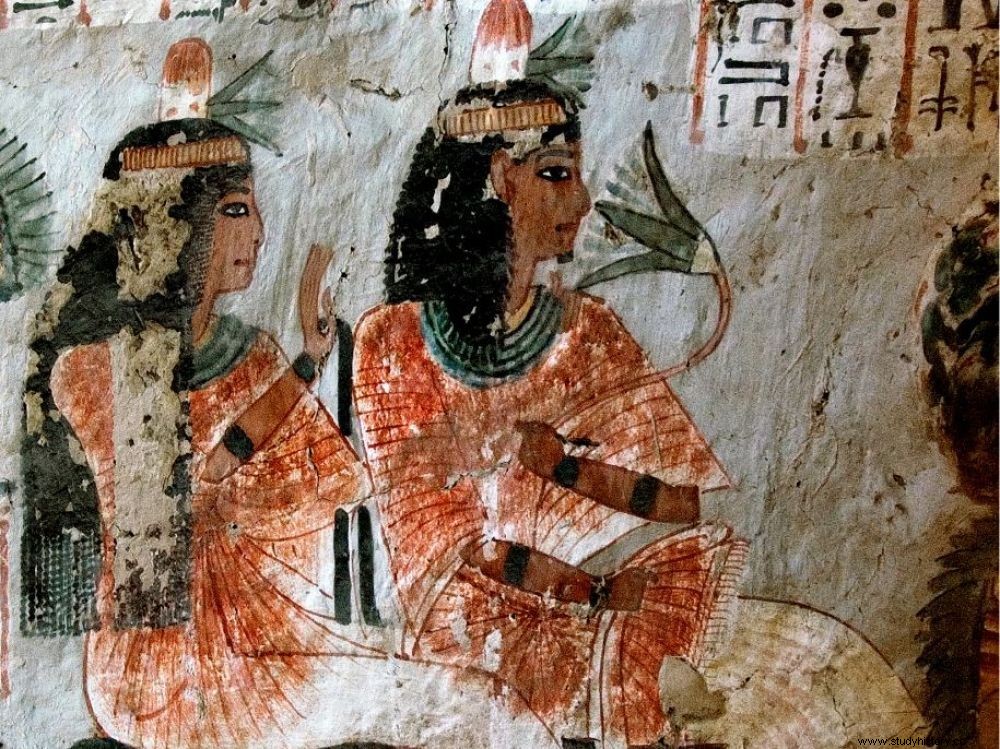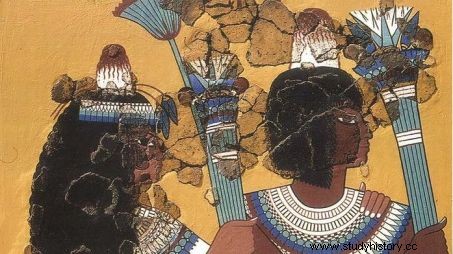An archaeological study shows that the strange cone-shaped headdresses represented on the walls of certain Egyptian monuments were not just an iconographic ornament. Their discovery on two skeletons lifts part of the veil as to their meaning.

Two figures from Tomb TT255 of the 18 th dynasty, on the west bank of Luxor, adorned with a "head cone".
These ornaments have long baffled Egyptologists. As early as the New Kingdom (1549 BC), small cones in creamy colors were sometimes featured on the hairstyles of men and women in the decorations of the walls of temples and tombs. They have long been presented as fragrant "clods" supposed to "melt" on the hair like snow in the sun, or as symbolic elements like the halos and other tongues of fire painted above certain characters in religious iconography. Christian.

Facsimile of a decoration from the tomb of two sculptors from Thebes, during the reign of Amenhotep II, around 1450 BC. © Josse / Leemage / AFP
But archaeological excavations at the site of el-Amarna, the short-lived city dedicated to the sun god Aten, founded by the famous heretical ruler Akhenaten (Amenhotep IV), revealed for the first time their true existence and lifted part of the veil over their meaning.
These ornaments have long baffled Egyptologists. As early as the New Kingdom (1549 BC), small cones in creamy colors were sometimes featured on the hairstyles of men and women in the decorations of the walls of temples and tombs. They have long been presented as fragrant "clods" meant to "melt" on the hair like snow in the sun, or as symbolic elements like the halos and other tongues of fire painted above certain figures in religious iconography. Christian.

Facsimile of a decoration from the tomb of two sculptors from Thebes, during the reign of Amenhotep II, around 1450 BC. © Josse / Leemage / AFP
But archaeological excavations at the site of el-Amarna, the short-lived city dedicated to the sun god Aten, founded by the famous heretical ruler Akhenaten (Amenhotep IV), revealed for the first time their true existence and lifted part of the veil over their meaning. And this thanks to the analysis of two 3300-year-old skeletons still adorned with this mysterious headdress, the results of which have just been published by archaeologist Anna Stevens, from Monash University in Melbourne (Australia) in the journal Antiquity.

One of two skeletons discovered at Amarna, still bearing the remains of a head cone. © Amarna Project
The first body, that of a young woman aged 20 to 30, was found in 2010, while the other, released five years later, is that of a teenager aged 15 to 20. They were wrapped in mats buried directly in the sand. The use of an X-ray spectrometer (XRF) allowed non-destructive analysis of their strange headgear, which is 10 cm wide at the base and 8 cm high. In very poor condition, they were studded with holes, probably vestiges of the passage of necrophagous insects.
No animal fat, perfume or resin
According to the recently published results, it appears that they were fashioned from beeswax and that they contained no animal fat, perfume, resin, frankincense or myrrh as had sometimes been described. The idea then being that by "melting" on the head of their wearer, these cones would have participated in the purification of their owners, before these took part to rituals related to the funerary world. Furthermore, the examinations showed no trace of any "runoff" on the analyzed hair, which the desert preserved relatively well.
These analyzes also make it possible to rule out the hypothesis that these cones were reserved for the elite, the skeletons studied being those of people of modest origin. They were indeed buried in a huge cemetery of 700 graves where the workers engaged in the construction and maintenance of the city were buried. However, researchers still do not know the precise meaning of these headdresses. "Perhaps they relate to ideas of purification, fertility and resurrection?" , risk the signatories of the article. If the existence of these objects is now proven, the enigma remains.

Two figures wearing head cones, in one of the murals from the city of Akhenaten. © Amarna Project.
Amarna, the city of Akhenaten
In year 5 of his reign, Akhenaten (Amenhotep IV), the famous heretical pharaoh who ascended the throne in 1346 BC, had a new city built to mark his break with the old order. Tell el-Amarna is thus located in the middle of the desert, 300 km from Thebes, the religious capital of its predecessors. From an ocean of dunes, in just 15 years he had created an immense complex with its palaces, temples and sanctuaries dedicated to Aten, the unique sun god whom the ruler of the 18
th sup>
dynasty then tried to impose to eclipse the old deities.
